It was a long drive of 4 ½ hours each way in one day but well worth the effort. The Legacy Museum and The National Memorial for Peace and Justice in Montgomery, Alabama are “must-sees” to gain a better understanding of, and an emotional connection to, the story of enslaved people in America.
“The Legacy Museum From Enslavement to Mass Incarceration is built on the site of a former warehouse where enslaved black people were imprisoned in Montgomery.

Section of The Legacy Museum
The museum employs unique technology to dramatize the enslavement of African Americans and tell the story of how slavery evolved through the eras of racial terror lynchings, legalized racial segregation, and mass incarceration.” One of the technologies we found most eye-opening is the use of a graphic, presented in a television monitor, that shows a red column for every 100 people enslaved in a location from arrival in North America to 1860 and how the domestic slave trade moved millions of people, enslaved and free, from the upper south and north to the lower south. The visual is so dramatic that it leaves you standing in awe when you see how many columns, now represented as red dots because of the sheer number of them, are clustered mainly in the southern states but also in the northeast and Midwest. The rest of the museum’s offerings are equally captivating so, even though you may know some of the history and statistics of slavery in the US, you are continuously engaged. With such a variety of media and interactive presentations it is an unforgettable experience. What we were also pleased to see was people of all ethnicities in the museum and many with their children. (Museum Note: No photography or audio recording of any kind is allowed.)
The National Memorial for Peace and Justice, about 8 blocks away,

Memorial situated on top of a hill
is an outdoor space that “…is the nation’s first memorial dedicated to the legacy of enslaved black people…
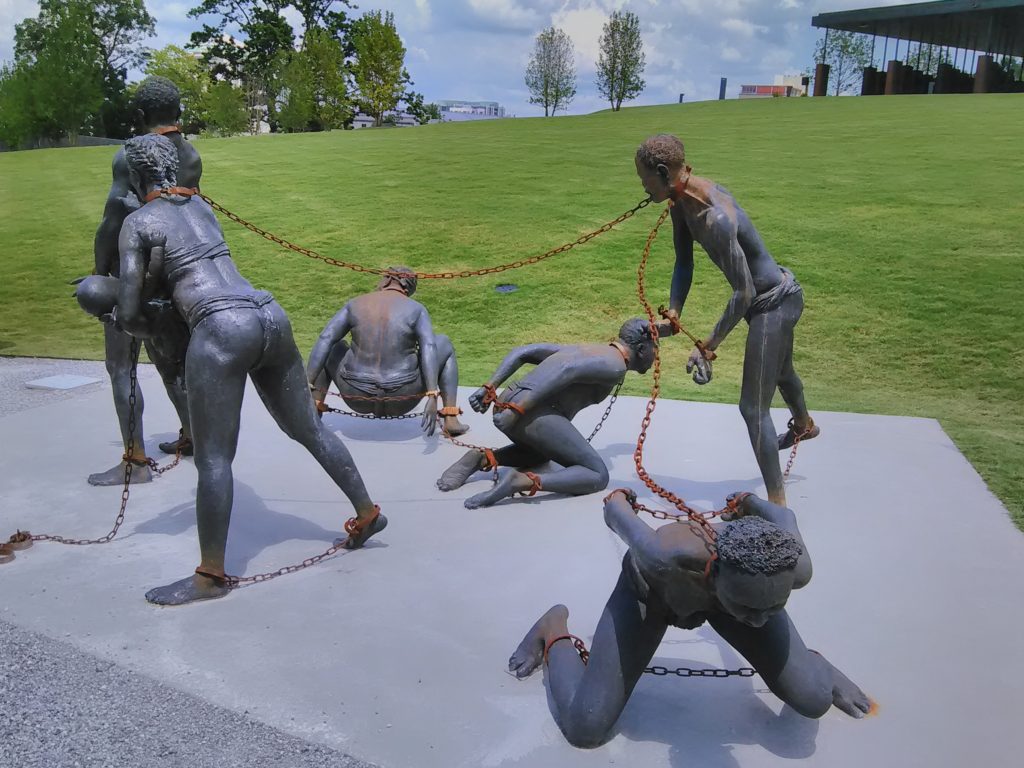
Sculpture of the enslaved on the journey to the top of the hill
terrorized by lynching…segregation and Jim Crow… Set on a six-acre site, the memorial uses sculpture, art, literature, and design to contextualize racial terror and oppression.” This is the space many of you have probably seen on television with the hanging metal rectangles that “…identify more than 4,000 African American men, women, and children who were lynched between 1877 and 1950 and to document the impact of these acts on the community.”
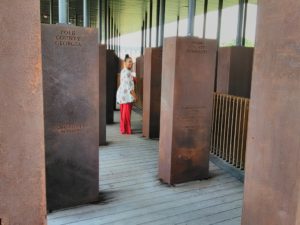
Beginning of the Markers
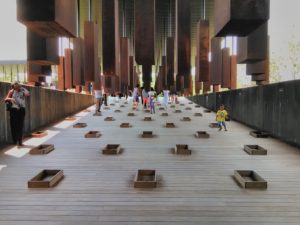
Descending walkway of Markers with symbolic dirt markers underneath
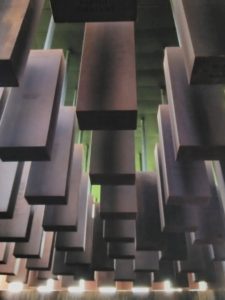
Rows of hanging Markers
Again, there were multi-ethnic visitors engaging in this very powerful memorial.
Of course, since we were in close proximity, we had to visit the Edmund Pettus bridge in Selma, Alabama.
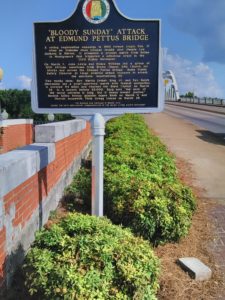
Edmund Pettus Bridge marker Selma, AL
This iconic structure brought to the surface powerful feelings associated with the struggle of people of African descent, and indeed all oppressed people in the United States, to obtain social justice.
We at CreoleGen will continue to highlight places of interest where our readers can gain knowledge and find resources that impact their family history research.
Source: The Legacy Museum and The National Memorial for Peace and Justice brochure.
Lenora Gobert



We visited the National Memorial, and The Legacy Museum in May. They provide a solid focus on the degree of terrorism used to enforce an ideology of white supremacy, and the loophole in the 13th Amendment and the criminalization of most African American activity to maintain a plantation system post 1865 both publicly throughout the South, and within the prison industrial complex. That 13th Amendment loophole still pervades the prison plantation system today, and furnishes the feeding of the for-profit prison systems flourishing today. The visit left me tremendously angered. Major kudos to Mr Brian Stevenson and all those who’ve worked so hard to bring these two installations to the public.
Oh My God! How awesome! When the students in my classes tell me, they would not have allowed themselves to be enslaved (I am a substitute teacher). I simply tell them our ancestors were brave enough to survive. We are their descendants. The “brave ones” left no legacy, as they were lynched!
Are we descendants of the cowards? Hell no, my ancestors were survivors!
When was this museum opened? My personalized tour a few years ago covered alot of ground. I spent some time at the National Park which is the half way point between S/M where the marchers spent the night and a few short stops between the Park and Selma. I will have to go again!! I parked the car and walked back and forth across the Pettus bridge and around Selma then back to Montgomery.I thoroughly enjoyed my tour and gained much history.
It opened earlier this year.
Very interesting. Every state that had slaves historically should have such a facility regarding USA slavery. This will give balance to the former Confederates States of America battlefields and museums like the annual celebration near Walmart Homeoffice in northwest Arkansas. Those reenactments of the Civil War annually keep the bigotry of racial intolerance alive. Whites come from all over the country to don a gray Confederate uniform and reenact that battle. Would the USA allow Great Britain, Germany or Spain to give homage to a historical battle on USA grounds, I think not. Tell some more of the truth with all the history and not just whitewashed history.
Lenora,
Thank you for detailing your visit. I look forward to visiting the museum this fall.
What a great description of the sites that you visited. I thank you for sharing your experience and features of such an important historical venue.